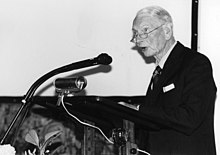John Grahame Douglas Clark
| Sir Grahame Clark | |
|---|---|
 |
|
| Born | 28 July 1907 Bromley, England. |
| Died | 12 September 1995 (aged 88) Cambridge, England |
| Nationality | British |
| Fields | Archaeology |
| Known for | Mesolithic |
Sir John Grahame Douglas Clark, CBE, FBA (28 July 1907 – 12 September 1995), who often published as J. G. D. Clark, was a British archaeologist who specialised in the study of Mesolithic Europe and palaeoeconomics. He spent most of his career working at the University of Cambridge, where he was appointed Disney Professor of Archaeology from 1952 to 1974 and Master of Peterhouse from 1973 to 1980.
Born in Kent to an upper middle-class family, Clark developed an early interest in archaeology through his collection of prehistoric flint tools. After an education at Marlborough College, he proceeded to Peterhouse, Cambridge (the oldest of Cambridge University's colleges) there attaining both his undergraduate and then doctoral degree. For the latter, he produced a thesis and published monograph focusing on Mesolithic Britain. In 1932 he co-founded the Fenland Research Committee, through which he excavated several prehistoric sites in the East Anglian Fens. He was also a senior member of the Prehistoric Society of East Anglia, playing an instrumental role in transforming it into The Prehistoric Society in 1935. He served as the editor of its academic journal, the Proceedings of the Prehistoric Society, from 1933 until 1970.
During the Second World War, Clark was drafted into the Royal Air Force Volunteer Reserve. He remained in Britain, working on aerial reconnaissance, and wrote further archaeological articles in his spare time. After the war he returned to Cambridge University, where he was employed as a fulltime lecturer. Over the course of 1949, 1950, and 1951, he excavated the important Mesolithic settlement site of Star Carr in North Yorkshire. Other excavations carried out under his directorship included that of an Iron Age settlement on Micklemoor Hill, Norfolk, and the Neolithic site of Hurst Fen, Suffolk. In 1951 he was made a Fellow of the British Academy, in 1952 appointed to Cambridge's Disney Chair, and in 1959 elected President of the Prehistoric Society. In later life he travelled the globe more extensively, often as a visiting professor; he also wrote more prolifically, although these books typically received a less enthusiastic reception than his earlier work.
...
Wikipedia
